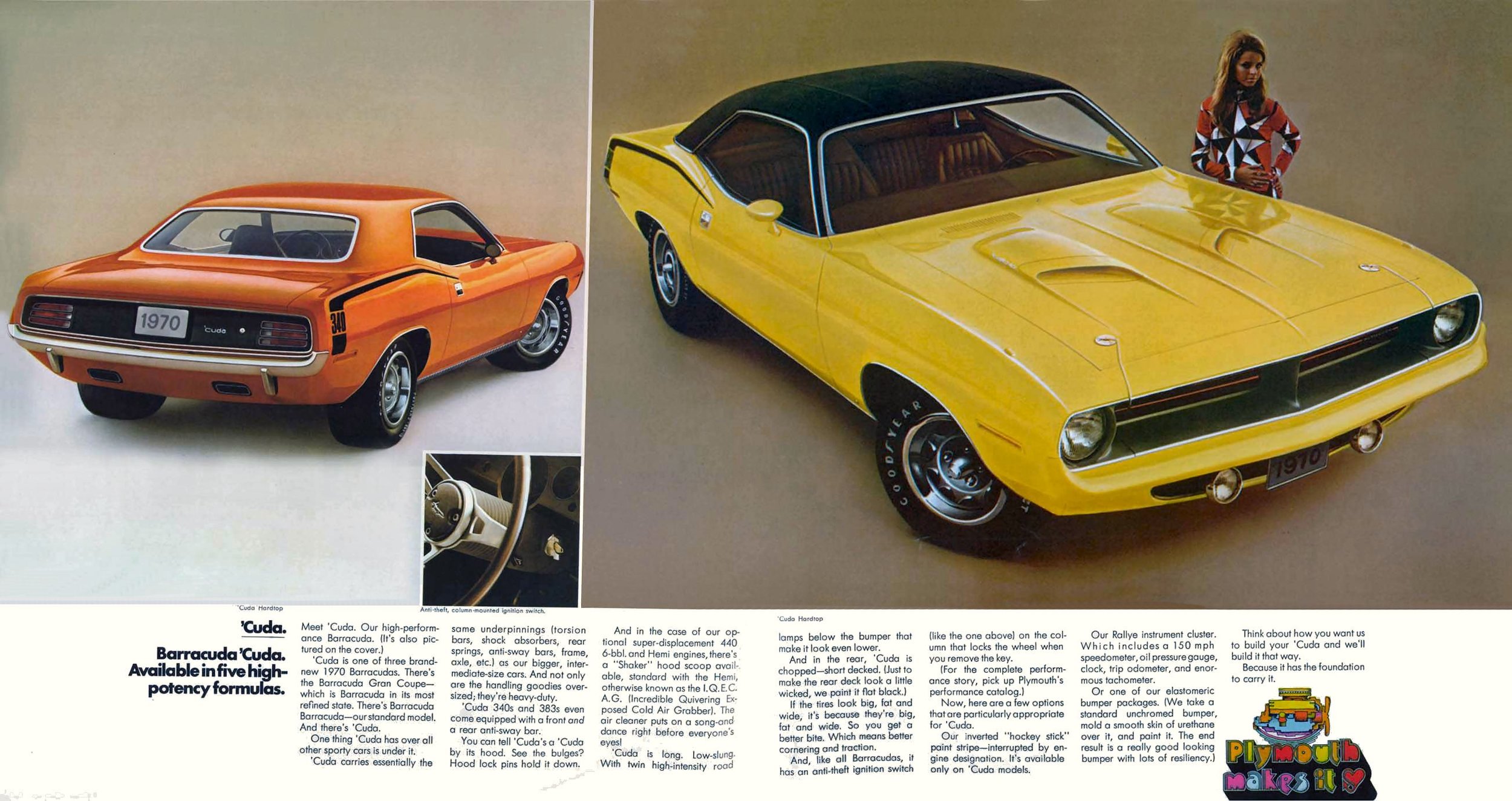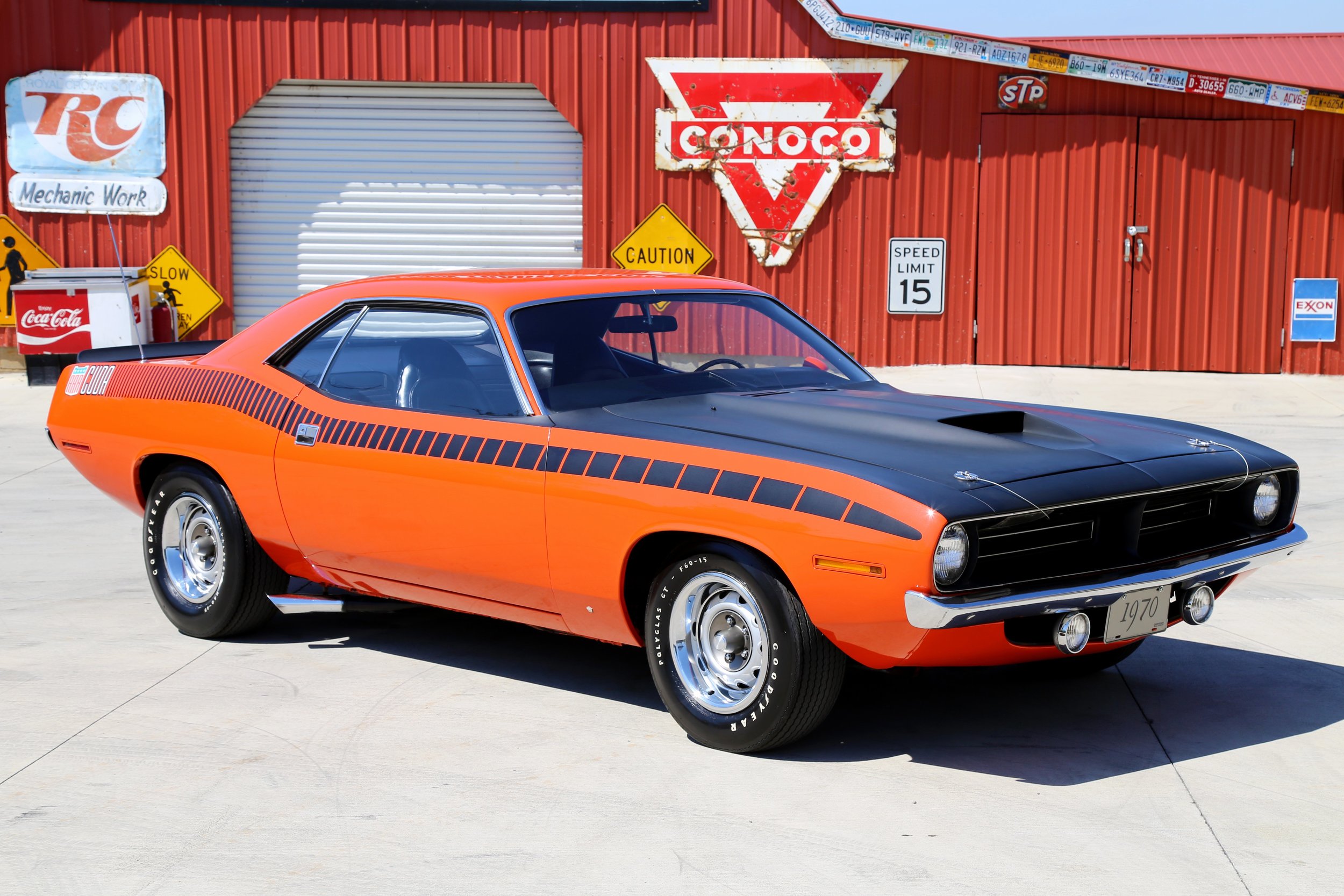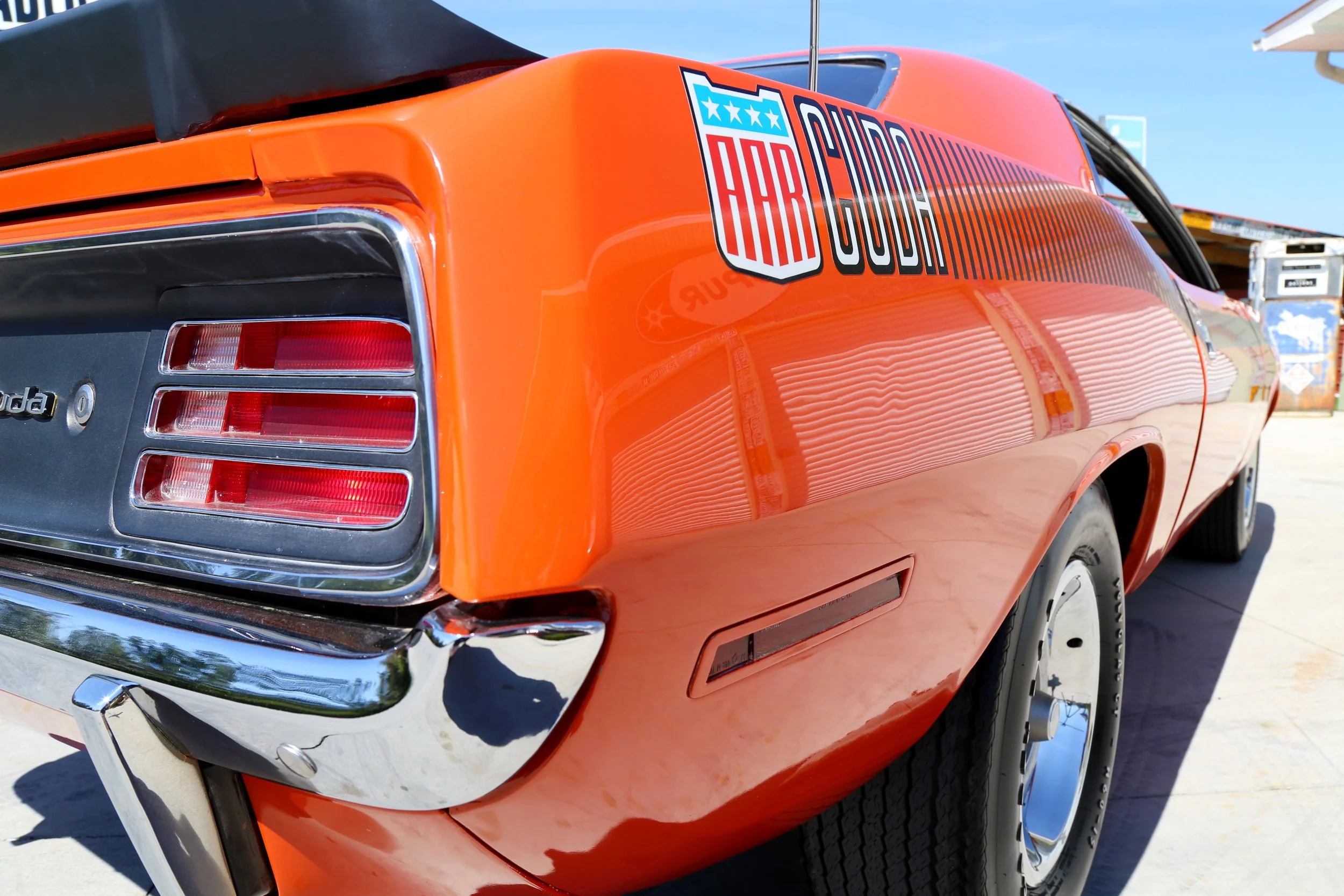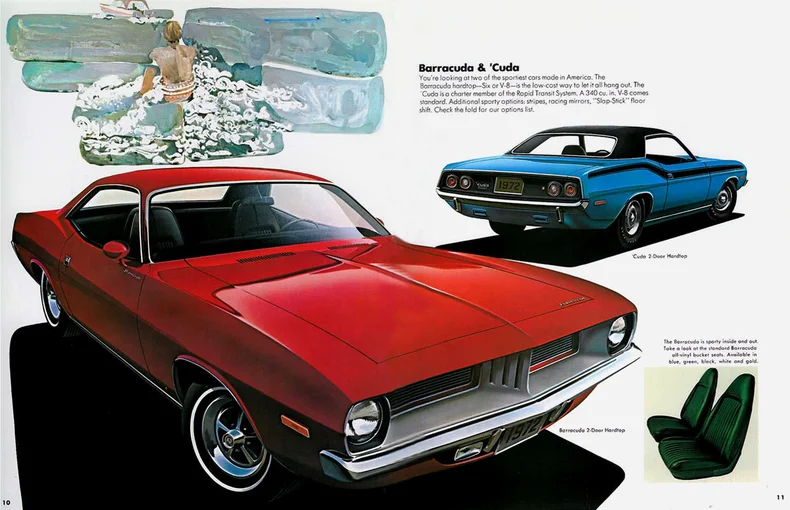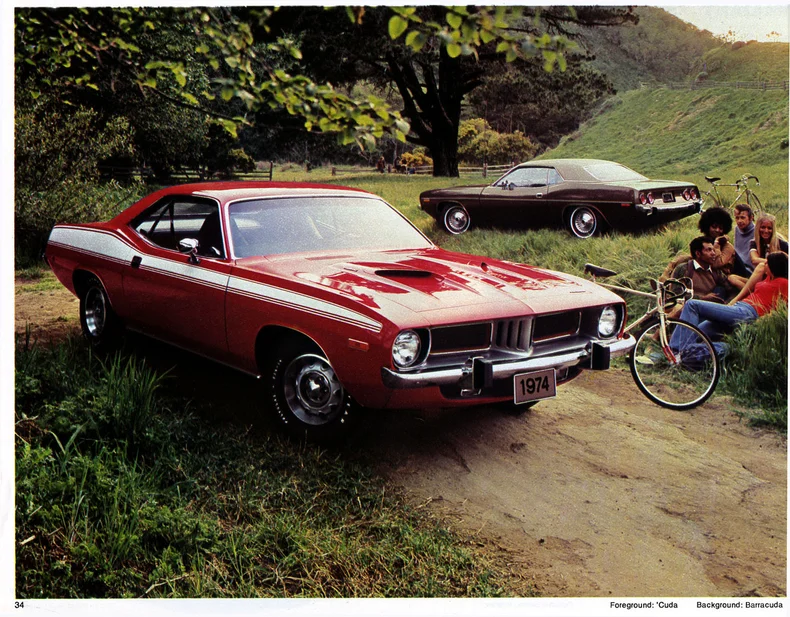History of the Plymouth Barracuda
The Creation
In the beginning, there were family cars, but the people wanted more. They wanted something they could afford (but wasn’t cheaply made), something that looked fresh, and something that would go fast.
The word around Detroit was that Ford was planning to introduce a sporty new compact car based on the Falcon chassis and running gear (this car was to be the 1964 1/2 Ford Mustang).
Chrysler stylist Irv Ritchie sketched out a fastback version of the Valiant, which at the time, was Chrysler’s most “sporty” model.
Budgets were tight, but the company’s executives wanted to have an entry in this rapidly growing market (smart move) and stealing some of the sales from Chevrolet’s Corvair Monza models wouldn’t hurt either.
What’s in a Name?
Chrysler had to decide what to call this new car. Names are important. They can evoke a sense of speed, fear, ferocity, or in the case of one of the first names suggested, a chubby bear eating bamboo. Yea, that’s right, the Plymouth executives wanted to name the new model Panda. PANDA.
Needless to say, this was unpopular with the designers and the name was vetoed in favor of Barracuda.
Giving the People What They Want
What do they want? Compact sized cars that were affordable (standard 6 cylinder and basic interior) but could be kitted out with a powerful V8 and custom accessories. This is known as the “pony car”.
In the marketplace, the Barracuda was viewed as “obviously” a fastback version of the Valiant, which had a frugal family image. Plymouth had to figure out a way to combat that, so they pitched the Barracuda as a car “for people of all ages and interests”. Meanwhile, the sporty Mustang was marketed with abundant advertising to young professionals and with a youthful image, this proved to be a huge strength for Ford and a weakness for Plymouth.
1964
April 1st, 1964 the Plymouth Barracuda debuted. Side note: Plymouth beat Ford to the punch on launching the first pony car.
The powertrains offered were identical to the Valiant’s:
170 Slant-6 | 101hp
225 Slant-6 | 145hp
274 V8 | 180hp
Total Production: 24,552
1965
A few new options were introduced as the competition amongst pony cars heated up. The 273 engine was now available as an upgraded Commando version with a 4-barrel carburetor, 10.5:1 compression, and a more aggressive camshaft. With these and other upgrades, the horsepower increased to 235.
A new package was also introduced this model year:
Formula S
Commando V8
Suspension upgrades
Larger wheels and tires
Special emblems
Tachometer
After the start of the 1965 model year, disc brakes and factory-installed air conditioning became available.
Total Production: 61,521
1966
For 1966, Plymouth introduced a few changes to the styling of the Barracuda. New taillights, new front sheet metal, and a new instrument panel freshened up the look of the now two-year-old model line. With the addition of the new instrument panel, now there was room for an oil pressure gauge and tachometer on models that were equipped with those.
For 1966, the large stylized “V’ trim above the deck lid was changed to a unique Barracuda fish logo. This was another step in Plymouth moving to make the Barracuda its own distinct model.
Total Production for 1966: 38,029
1967
1967 began the second generation of the Plymouth Barracuda and while it still shared many components with the Valiant, it was redesigned with model-specific sheet metal, and a convertible and hardtop coupe joining the lineup of body styles available.
The design team for the 1967 Plymouth Barracuda included multiple people, among those were Milt Antonick and John Samsen. Design cues included a concave rear deck panel, wider wheel openings, curved side glass, and S-curved roof pillars on the hardtop. The rear portion of the roof on the fastback coupe was more streamlined, and the back glass was quite a bit smaller compared to previous models.
The design wasn’t the only aspect of the Barracuda that got some attention. New engine options were introduced as well.
2 and 4 barrel versions of the 273
383 “B” big-block rated at 280hp
This was only available with the Formula S package
Total Production: 62,534
1968
“So you’re coming up to the Christmas tree and the exhaust is going bappetybappety-bappetybappety and all those little internal bits are going whumpawhumpawhumpa-whump and you’re out here to grind the sound barrier into bite-sized equations with your howlin’ Barracuda”
The design of the Barracuda remained unchanged for the 1968 model year but there were a few notable changes to the engine lineup:
273 was replaced by the 318 LA engine as the smallest V8 available
340 LA 4-barrel was released
383 Super Commando engine was upgraded with the intake manifold, camshaft, and cylinder heads from the Road Runner and Super Bee. Due to the more restrictive exhaust manifolds specific to the A-body cars, the output was limited to 300hp.
GROUND SHAKING TRACK MACHINE
This is a completely biased opinion but in 1968, Chrysler built one of the most badass cars to come out of Detroit.
The 1968 Plymouth Barracuda Super Stock - B029
Plymouth made approximately 50 fastback Barracudas (tag code B029) that were built by Hurst and equipped with the 426 race-tuned Hemi for Super Stock drag racing. Known as “A-bombs”, these cars saw a serious weight reduction as well. With acid-dipped doors, Lexan instead of glass, factory delete of anything and everything not essential to life on the drag strip (back seat, sound deadener, seam sealer, insulation, heater, radio, and window crank) this Barracuda was primed for the track.
Total Production for the 1968 year: 45,412
1969
Plymouth began placing an emphasis on performance with the 383 getting an upgrade to increase output to 330hp and Plymouth introduced the ‘Cuda trim package. Based on the Formula S option, the ‘Cuda package was available with either the 340, 383 and a brand new option for 1969, the 440 Super Commando V8.
Flower Power
1969 saw a new option released for a few of the Plymouth models. The Mod Top was a vinyl roof with a floral motif that was sold as a package option with seat and door panel inserts done in the same pattern. This option was only available for the 1969 and 1970 model year.
Total Production for 1969: 31,987
1970
The third generation of the Plymouth Barracuda began with the 1970 model year. This year saw a complete overhaul of the Barracuda, gone was any resemblance to the Valiant. The all-new model, styled by John E. Herlitz, was built on a shorter, wider version of Chrysler’s existing B platform, called the E-body. This redesign got rid of any “economy car” notions.
Three trim options were offered for 1970:
Barracuda (base model)
Barracuda Gran Coupe
‘Cuda
With the overhaul and move to the E-body platform, the engine bay gained quite a bit of space allowing for more engine room. Bigger engine bay = Bigger engines! The Plymouth Barracuda with the 426 Hemi was released to the retail market for the first time (and the people rejoiced!)
For 1970, the Barracuda had multiple engines to choose from:
198 Slant-6 | 125hp
225 Slant-6 | 145hp
318 V8 | 230hp
340 V8 | 275hp
383 V8 w/4-barrel carburetor and dual exhaust | 330hp
440 Super Commando Six Pack (3, 2-barrel carbs) | 390hp
426 Hemi | 425hp
Plymouth also saw an opportunity with this new model year. Their model line currently boasted multiple performance muscle cars, Road Runner, Duster, and ‘Cuda, so they saw the chance to promote their full line up of muscle cars while also creating a club, selling merchandise, and selling high-performance parts. This marketing campaign was known as the “Rapid Transit System” (We can dive more into that later).
Options available for the Plymouth Barracuda went beyond just the engines. With the Barracuda, you could choose options such as decal sets, hood modifications, “high impact” color exterior paint, shaker hood, and elastomeric colored bumpers (available for both front and rear).
The AAR ‘Cuda
Tired of Ford and Chevy dominating the SCCA Trans-Am Series, Chrysler wanted a piece of the pie. Plymouth hired Dan Gurney’s All American Racers to build and campaign cars to be driven by him and Swede Savage. At the time, SCCA homologation requirements dictated that a manufacturer had to build a minimum of 2,500 street versions in order to compete. There were a total of 2,724 built, all during a five-week period between March and April 1970.
The street-version AAR had a 340 V8 topped with three, 2-barrel Holley carbs, putting down an underrated 290hp at 5,000rpm.
The AAR ‘Cuda boasted multiple unique features:
Cylinder heads specific to this model
Forged crank and rods
Aluminum intake manifold
Larger brakes
Rear deck spoiler
AAR Suspension: special front and rear sway bars and heavy-duty shock absorbers
Side exit exhaust
Flat black finish to the grille, hood, tops of the fenders, upper door edges, and tail panel
Proprietary hood made of fiberglass with a functional air scoop and hood pins
Strobe stripe that ran the length of the car ending with a red, white, and blue AAR crest
75 segments make up the entire stripe, each decreasing in width
Total Production: 55,499
1971
This year brought new design changes for the Barracuda, with a new grille, dual headlights, new taillights, side “gills”, seat, and trim differences.
The engine options for 1971 would remain the same as 1970, with the main change being that the 340 6-barrel was gone and the 4-barrel carbureted 440 V8 was no longer on the options list but could be special ordered.
Total Production: 18,690
1972
Another new year, another year of design changes. Plymouth returned to single headlights and with that change, brought a new grille. There was a significant change to the taillights with a change to the four circular taillights.
Emissions Standards Killed The Muscle Car
With the gas crisis and new emission standards, changes were being made. Gone were the thundering torque monsters of the “true” muscle car era. 1972 said goodbye to the 383, 440, and 426 Hemi. Even the 340 and the 318 were detuned to meet the emissions standards.
Total Production: 18,450
1973
More federal regulations required more changes. In 1973 safety bumpers were added to the front and rear. As with other vehicles of the time, there was a progressive decrease in the Barracuda’s performance. Increasingly stringent safety and exhaust emission regulations meant that big-block engine options were discontinued (the angels wept). The remaining engines were further detuned to reduce exhaust emissions, which also reduced their power output.
Total Production: 22,213
1974
The only notable difference for 1974 (and offered in late 1973) was a slightly more powerful 360 V8 (245hp) that replaced the 340. By 1974, the Barracuda was on its way out. Pony car sales were plummeting, and while there were proposals made for a new generation of E-bodies, the heads of Chrysler weren’t interested in continuing a product line that didn’t fit into its plans for a future of Aspens, Horizons, Omnis, Valiants, and Volares. As consumers looked for fuel-efficiency and economy, there was no longer a place for the high-performance muscle cars of the early ’70s.
April 1, 1974, 10 years after Plymouth beat Ford to market with the first pony car, Barracuda production ended.
1975 Plymouth Barracuda | The One That Got Away
Chrysler had a four year lead time from design to production so the design and review process for the 1975 model year was occurring in the spring of 1969. With the pony car market going strong, a 1975 Barracuda was planned. There were two separate models sculpted out of clay and ultimately the final proposal for the ‘75 Barracuda was a blend of both designs.
In the fall of 1969, the final designs of the ‘75 Barracuda were approved and the clays were transferred to a fiberglass body which was then modified to look like a completed car.
1975 Plymouth Barracuda Concept | Photo Source: Hot Rod
From there, the prototype was taken to Cincinnati, Ohio to be viewed by a consumer group for feedback. Sadly, the results weren’t great, they weren’t even good. “That wild body went to Cincinnati of all places, and it was a disaster, “ remembers designer Milt Antonick. “I came back from Cincinnati and realized it was all over; management didn’t want muscle cars anymore. It was the saddest day of my career at Chrysler.”
As if an omen to the future, the ‘75 Barracuda fell off a forklift during transport and was damaged.
2020 Barracuda?
Rumors that the Plymouth Barracuda could make a comeback have run rampant for years. With the return of the Dodge Challenger, those rumors have been fueled even further. A quick Google search of “2020 Plymouth Barracuda” yields multiple results ranging from “It’s definitely coming next year” to “No way, it’s not happening”
I’ll believe it when I see an announcement from Dodge/FCA, haha.
What are your thoughts? Do you see a 2020/2021 Barracuda in our future?
Sources and such:








